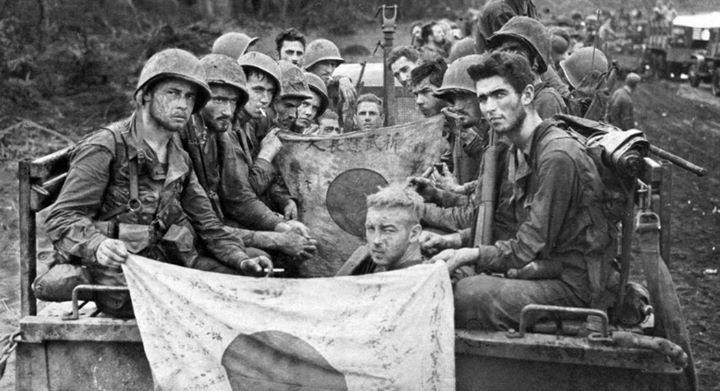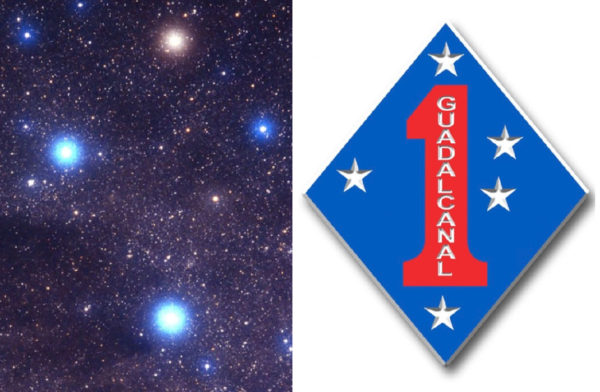Guadalcanal and the starry cross
Celestial gift from God comforts embattled U.S. Marines in the South Pacific
By W. Thomas Smith Jr.
I’VE BEEN THINKING A LOT ABOUT MY MARINE CORPS this week for some reason: I think because February marks the 76th anniversary of the Battle of Iwo Jima. That, and the fact that every now-and-then the things of the Corps – both real-life memories and only-read histories – come rushing back to me without any proverbial rhyme or reason. Not sure why: They’re just there all of a sudden, and they’re not easy to tamp down.
In recent years, I’ve tried not to think so much about the Marines. Not since 2008, when the outright and steady cultural emasculation of the Corps began. But we won’t go there. Not here. Not now. It’s too painful. In some ways more so than the most unhappy memories of my own time in (and later with) the Corps.
Fortunately for me, the fond memories far outweigh the unhappy ones. Though some have suggested that my fond recollections are nothing more than looking back through rose-colored glasses. I think not.
After all, even in hardship everything in the Corps was always so clean, so razor-sharp, so perfect – so “squared away” as we would say – austere, yes, but just. There was a strange purity even within the most profane environs.
Then there were the things that the Marine Corps gave, taught, and ignited within us. There were the things that were hammered into us day-after-day as regards the pitfalls of selfishness. There were the impossible-to-describe things that honed our instincts and heightened our awareness (especially for those of us in the infantry units). And there were the equally important things that will forever more clearly allow us to see what’s TRULY GOOD (in the Marines and in life) and what is just as surely broken in this world. No wonder some outsiders have referred to us as “cult-like,” or as former Assistant Secretary of the Army Sara Lister referred to us: “Extremists.”
Be that as it may, I was reminded of one of the TRULY GOOD albeit simple things last week as several friends and I gathered for Sunday School. Taking my usual seat in the back of the class, I struck up a conversation with a friend – an accomplished attorney and erudite Sunday School teacher – whose wife’s older brother was a Marine rifleman who lost his life on a remote hillside in Vietnam.
My friend, who has a keen interest in all things, asked me a particular question about military organization. Our conversation progressed into a discussion of legal command, the regimental system, and what composed a brigade and a division within either the Army or the Marine Corps.
Like me, my Sunday School friend also has an interest in and knowledge of stars, planets, and constellations; so it wasn’t long before I was sharing with him the little-known story of the arrangement of stars we see in the emblem [see picture] and World War II-uniform patch then referred to as a “battle blaze” of the 1st Marine Division.
The five stars in the “blaze” depict the Southern Cross constellation, actually the asterism known as “Crux,” which is clearly visible in the Southern Hemisphere and only occasionally visible in the Northern Hemisphere at latitudes just above the equator.
Why and how that particular group of stars found its way onto an official U.S. Marine divisional emblem is one of the previously mentioned TRULY GOOD things that make the Corps what it is, and Marines who they are.
According to the story, the Marines who landed and fought on Guadalcanal in 1942 were overwhelmingly (though not all) Christian boys and men. Christian is key as we look further into this story. And I say “boys” because as a whole they were very young. Then as today, the Marine Corps is traditionally composed of the youngest men of all the American armed forces. ‘Why’ is a question we’ll save for another discussion.
The fighting on “the ‘Canal,” as the Marines referred to it, was horrible beyond imagination: The Japanese launching suicidal wave attacks (Banzai charges) over and over again against the young Marines, with the fighting often devolving into hand-to-hand slugfests. When the Japanese soldiers weren’t attacking, the offshore enemy ships were mercilessly shelling the Americans.
During short lulls in the fighting, breaks in the shelling, and clearings in the cloud cover; the exhausted Marines would look up into the night sky, see the starry cross, and seemingly draw emotional and spiritual – thus mental and physical – strength from it.
To the Marines, it was a heartening reminder that God was there with them: “The heavens declaring the glory of God,” as we read in Psalm 19.
This is not to suggest that God wasn’t also with the young Japanese soldiers. The Japanese may not have been Christians. But God created them in His own image, so surely He loved them too. Which reminds me of the story of Imperial Japanese Navy Capt. Mitsuo Fuchida, best known for leading the first wave of attacks against Pearl Harbor in 1941. Fuchida survived the war, surrendered his life to Christ, and became
a Christian evangelist and missionary traveling across the United States and Europe. Again, that’s another story.
As to the five ever-present stars above Guadalcanal; they were increasingly gazed upon by the men who despite their grim existence on “the ‘Canal,” made note of where in the night sky they saw the cross. They looked for it on clear nights. They pointed it out to fellow Marines. They encouraged Marines from other units to look for it. Word spread from squad to platoon to company to battalion and on up the chain.
Maj. Gen. Alexander Vandegrift, the future commandant of the Marine Corps who commanded the 1st Marine Division on Guadalcanal, became aware of his Marines’ focus on and fascination with the starry cross. Serving on Vandegrift’s staff was Lt. Col. (future Gen.) Merrill Twining, who was either tasked with designing or designed on his own the now-famous 1st Marine Division blaze in 1943.
When Twining designed the diamond-shaped blaze, he included the Southern Cross asterism among the featured elements, which also included a red numeral “1” with the name GUADALCANAL in white letters inscribed on the “1.” The colors of the blaze were red, white, and blue.
The Southern Cross is, of course, not entirely unique to the 1st Marine Division. It has been incorporated into other insignia and standards, including the national flag of Australia, which by the way is where the post-Guadalcanal 1st Marine Division was newly stationed when Twining designed the blaze.
In time, the 1st Marine Division became so reputedly feared by the enemy and so-respected by other American and allied forces, that soon after Vandegrift became commandant, he directed that no Marines wear unit patches distinguishing them from other Marine units.
“Because of the comparatively small size of the Marine Corps, it is undesirable to maintain in existence unnecessary distinction between the type of duty to which an individual is assigned, particularly from the point of view of esprit de corps,” read an Apr. 29, 1946 memo from Headquarters Marine Corps.
According to Marine Corps Times, the memo further stated, “shoulder insignia can foster both pride and prejudice.”
Marines are Marines, Vandegrift would argue, and no one Marine unit is superior to another, nor any one Marine better than the next.
So Marines of the 1st Marine Division removed the battle blaze from their uniform sleeves and put them in pockets, envelopes, and old shoeboxes.
Vandegrift, who received the Medal of Honor for his exemplary command of the 1st Marine Division, retired from the Marines in 1949. He passed away in 1973.
The Marine Corps has since changed, dramatically I might add.
It is hardly what Vandegrift would have envisioned it to be. Or what I would have wanted or even predicted as recently as 20 years ago. But it is what is. It’s still the Corps and the “blaze” remains. Marines who served in the 1st Marine Division still often wear a pin-version of it on their lapels. Some of the older retired guys wear the pin on their covers (caps). The starry cross is still there. And the story behind it is one of the seemingly simple TRULY GOOD things about being a Marine.
– W. Thomas Smith Jr. served in the 1st Marine Division.

